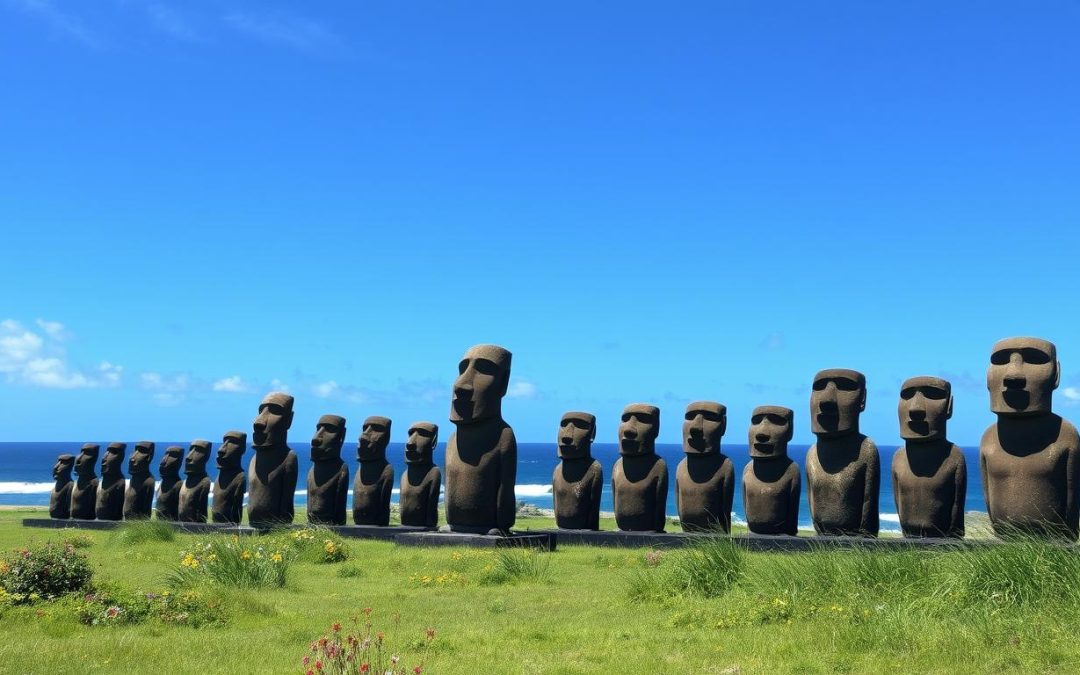Ever wondered about the secrets of the most isolated island on Earth? Easter Island (Rapa Nui) invites you with its mysterious moai statues and stunning views. It promises an adventure unlike any other place.
Easter Island is a marvel in the Pacific Ocean, showing human creativity and strength. It has over 1,274 petroglyph sites and about 900 amazing moai statues. These have fascinated explorers and researchers for years.
Your trip to this special place will reveal ancient wonders, beautiful landscapes, and a rich culture. From the giant moai statues to the clean beaches and volcanic areas, Easter Island is a unique travel experience.
Key Takeaways
- Explore over 900 iconic moai statues across the island
- Discover the most isolated inhabited place on Earth
- Experience unique Polynesian culture and history
- Enjoy diverse activities from hiking to scuba diving
- Witness breathtaking landscapes and archaeological sites
- Immerse yourself in the mystery of Rapa Nui
Understanding Easter Island: Location and Historical Significance
Easter Island is a special place in the Pacific Ocean. It’s a symbol of human history and culture. This island, known as Rapa Nui, shows us a unique civilization that lived in a very isolated spot.
Where is Easter Island Located
Easter Island is far from South America, over 2,000 miles away. It’s 63 square miles big. Its location in the Pacific makes it a fascinating spot for study and travel.
- Distance from South America: Over 2,000 miles
- Total Island Area: 63 square miles
- Geographic Position: Southeastern Polynesian Triangle
The Mystery of Moai Statues
The island has about 900 moai statues, some as tall as 32 feet. These huge statues are carved from volcanic rock. They represent the ancestors of the Rapa Nui people and show their amazing skill.
“The moai are not just statues, they are the living faces of our ancestors watching over us.” – Local Rapa Nui Elder
| Moai Statues | Details |
|---|---|
| Total Number | Approximately 900 |
| Maximum Height | 32 feet |
| Primary Location | Rano Raraku Quarry |
Cultural Heritage of Rapa Nui People
The Rapa Nui National Park covers almost half the island. It protects the island’s ancient sites. About half of the island’s 8,500 people are Rapa Nui, keeping their traditions alive.
The island’s history goes back centuries. People first arrived between 300 and 400 C.E. The Rapa Nui have faced many challenges, from Dutch explorers in 1772 to becoming Chilean citizens in 1965. They have shown great strength and resilience.
Essential Travel Planning for Your Easter Island Adventure
Getting ready for Easter Island (Rapa Nui) needs careful planning. This remote spot in Chile is full of mystery. You’ll want to make sure your trip is unforgettable.
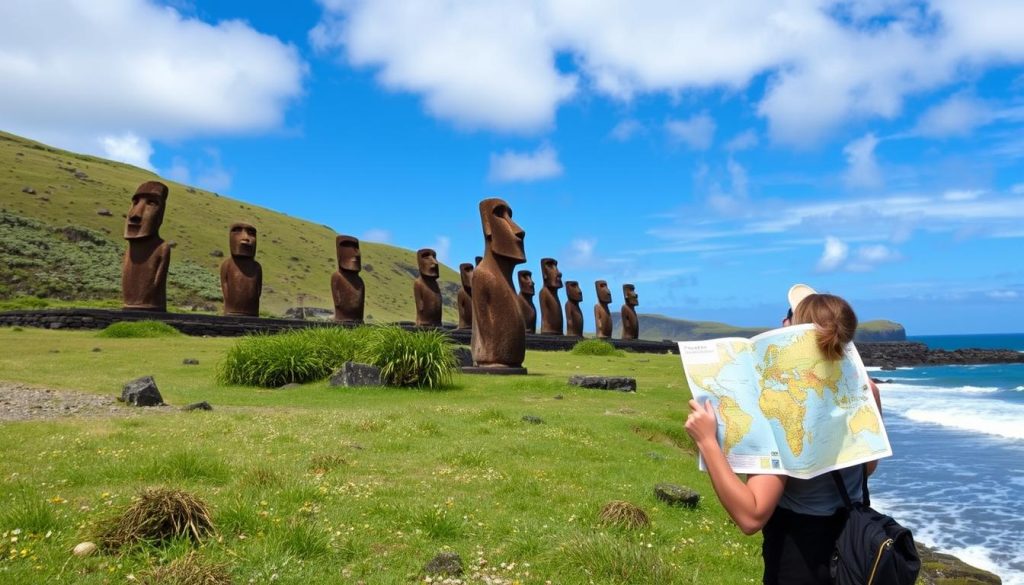
First, learn about the travel basics. LATAM Airlines is your only flight from Santiago. The 5-hour trip covers 3,500 kilometers of Pacific Ocean.
Best Time to Visit
The best time to see Easter Island is from December to March. During this time, the weather is nice, between 70°F and 80°F. It’s perfect for exploring the island’s wonders.
- Peak tourist season: December – March
- Comfortable temperatures: 70-80°F
- Recommended festival: Tapati Rapa Nui in February
Flight and Accommodation Insights
| Travel Detail | Information |
|---|---|
| Flight Operator | LATAM Airlines |
| Flight Duration | Approximately 5 hours |
| Recommended Advance Booking | 6 months prior to travel |
| Average Stay | 3-5 nights |
Planning your Easter Island trip is key. Book flights and hotels early. Also, pack clothes for the weather and outdoor fun.
Pro Tip: Bring layers, comfortable walking shoes, and sun protection for your Rapa Nui expedition.
With good planning, you’ll discover Easter Island’s secrets. You’ll see its ancient sites and cultural riches.
Exploring the Iconic Moai at Ahu Tongariki
The southeastern coast of Easter Island is home to a breathtaking wonder. Ahu Tongariki is the most impressive ceremonial platform. It showcases 15 majestic Moai statues, telling a deep story of Rapa Nui culture.
Best Photography Moments
Getting the perfect shot at Ahu Tongariki needs careful planning. The golden sunrise turns these ancient Moai statues into a magical scene. Here’s what photographers and travelers suggest:
- Arrive before dawn for the first light
- Use a wide-angle lens to capture the whole platform
- Bring a tripod for stable sunrise shots
Cultural Significance of the Site
The Moai statues are more than just stone figures. They represent the spiritual and cultural heart of the Rapa Nui people. Each statue stands for an ancestral chief or important leader, guarding the island’s history together.
“The Moai at Ahu Tongariki are silent witnesses to a civilization’s remarkable achievements and challenges.” – Archaeological Research Team
Visitor Preservation Guidelines
Visiting Ahu Tongariki means protecting this UNESCO World Heritage Site. Remember these important rules:
- Stay on designated paths
- Don’t touch or climb the Moai statues
- Carry out all personal trash
- Respect the cultural significance of the site
Your careful actions help keep this incredible treasure safe for future generations.
Discovering Rano Raraku: The Moai Quarry
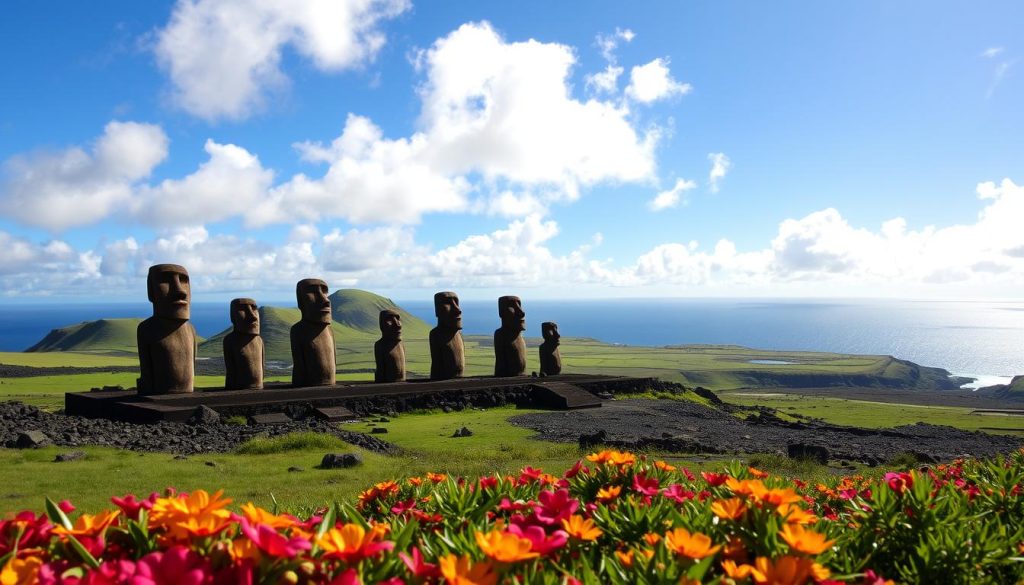
Rano Raraku Quarry is in the heart of Easter Island. It shows the amazing skill of the Rapa Nui people. This volcanic crater was where hundreds of Moai statues were carved. It’s like an open-air museum that time forgot.
Exploring this site gives you a peek into ancient stone-carving techniques:
- Over 397 Moai statues remain in various stages of completion
- Many statues are partially buried, showcasing the intricate carving process
- The quarry reveals the complex engineering behind Moai creation
“Rano Raraku is more than a quarry – it’s a window into the soul of Rapa Nui culture.” – Archaeological Expedition Notes
The views from the quarry are stunning. They show the huge scale of Moai production. Walking around the quarry gives you a special view of how these giant statues were made and moved.
| Rano Raraku Quarry Details | Interesting Facts |
|---|---|
| Total Moai Statues | 397+ unfinished statues |
| Location | Volcanic crater on Easter Island |
| Visitor Experience | Guided tours with archaeological insights |
Visiting the Rano Raraku Quarry lets you understand the unparalleled cultural legacy of the Rapa Nui people. It offers a deep look into the world of Moai statue creation. It’s a must-see on your Easter Island trip.
Beach Paradise: Anakena and Ovahe Beaches
Easter Island (Rapa Nui) is a stunning coastal getaway with its white sand beaches. Anakena Beach and Ovahe Beach on the north coast mix natural beauty with ancient sites.
Swimming and Sunbathing Opportunities
Anakena Beach is a tropical paradise with white sand and clear turquoise waters. Eight moai statues overlook the beach, making it a unique spot for relaxation. It’s great for swimming and sunbathing.
Nearby Archaeological Sites
Beach days can also include exploring nearby archaeological sites. Ahu Nau Nau, found in 1978, offers insights into Rapa Nui culture. It’s a great way to learn about history while enjoying the beach.
Local Amenities and Facilities
Enjoy a comfortable beach day with these amenities:
- Restroom facilities available
- Small parking area
- Limited food vendors
- Shade from surrounding palm trees
“Anakena Beach offers a rare combination of natural beauty and cultural significance that makes it a must-visit destination on Easter Island.” – Local Travel Guide
| Beach Feature | Details |
|---|---|
| Sand Color | White |
| Number of Moai | 8 statues |
| Water Conditions | Clear turquoise waters |
| Best Time to Visit | December to March (summer months) |
Pro tip: Bring sunscreen, water, and a camera to capture the breathtaking scenery of Anakena Beach on your Easter Island adventure.
Hiking Adventures on Easter Island
Easter Island (Rapa Nui) is a paradise for adventurers. It boasts volcanic landscapes and ancient sites. Hiking here means exploring some of the South Pacific’s most stunning trails, with Rano Kau Volcano being a top spot.
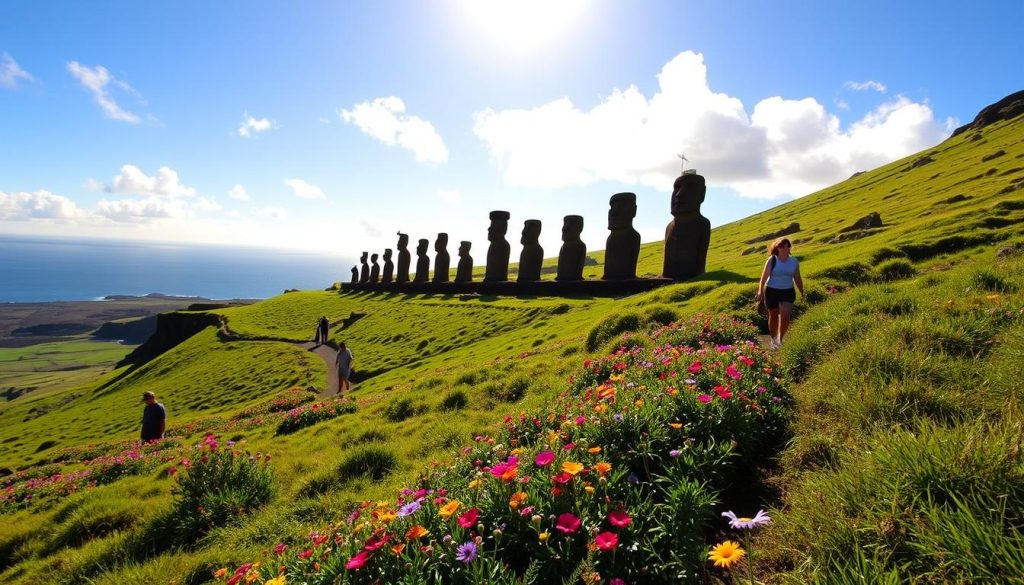
Exploring Easter Island on foot is a unique experience. The trail to Terevaka Volcano, the island’s highest point, is a must-try. This 2-hour hike offers breathtaking views of the Pacific Ocean from every angle.
Top Hiking Trails on Easter Island:
- Terevaka Volcano Summit (Highest point on the island)
- Rano Kau Volcano Crater Trail
- Orongo Village Historical Path
For those interested in history, Rano Raraku’s trails are a treasure trove. This volcanic quarry is where ancient Rapa Nui people carved their famous moai statues. You’ll find hidden petroglyphs and see the landscape that shaped their culture.
“Hiking on Easter Island is not just a physical journey, but a walk through living history.” – Local Rapa Nui Guide
For a great hike, remember to bring lots of water, wear good boots, and protect yourself from the sun. The best times to hike are early morning or late afternoon, when it’s cooler.
No matter your hiking level, Easter Island has trails for everyone. From the towering Rano Kau Crater to ancient sites, your journey will be unforgettable. It’s a chance to explore one of the world’s most unique places.
Easter Island (Rapa Nui), Chile: Best Things to Do – Top Picks
Easter Island is a place of magic, with a mix of ancient ruins, stunning landscapes, and rich culture. Rapa Nui National Park covers 43% of the island. It’s a paradise for those who love adventure and history.
Archaeological Sites Exploration
Exploring Easter Island’s ancient sites is truly amazing. The island is home to 888 moai statues on over 300 platforms. Don’t miss these key spots:
- Rano Raraku Quarry: Where moai were born, with both finished and unfinished statues
- Ahu Nau Nau: With 7 moai, 4 of which still have their top knots
- Ahu Tahai: The only site in town you can visit without a ticket
Outdoor Activities and Adventures
Easter Island is full of outdoor fun for thrill-seekers. You can:
- Hike to Terevaka Volcano, a 2-hour trek
- Snorkel in Hanga Roa Harbour when the tide is high
- Bike from Hanga Roa to Anakena Beach
Cultural Experiences
Dive into the Rapa Nui culture. The island has 1,274 petroglyph sites, including the “Birdman” figure. Visit Orongo village on Rano Kau volcano to learn about old traditions and competitions.
“Easter Island is not just a destination, it’s a journey through time and culture.” – Local Rapa Nui Guide
Easter Island has an average temperature of 20°C (68°F). It offers unique experiences at every turn. It’s a place where history, nature, and culture come together for an unforgettable adventure.
Marine Activities: Diving, Snorkeling, and Surfing
Easter Island is a paradise for water lovers. It offers a chance to explore the underwater world of Rapa Nui. This is more than just beach activities.
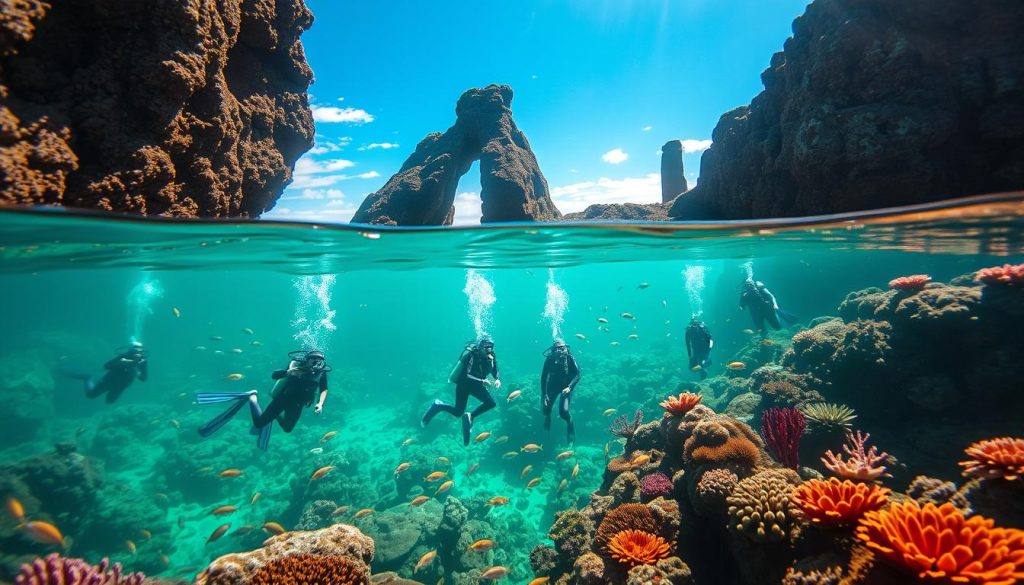
The waters around Easter Island are clear and full of life. You’ll see tropical fish and amazing underwater scenes. Whether you’re new to water sports or an expert, there’s something for everyone.
Top Marine Activities to Experience
- Snorkeling in pristine coastal waters
- Diving near submerged archaeological sites
- Surfing at unique island breaks
- Exploring marine wildlife habitats
At Hanga Roa harbor, you’ll see an incredible marine world. Sea turtles often swim near fishermen. This creates magical moments for those who love nature and photography.
Diving and Snorkeling Highlights
| Activity | Experience Level | Best Season |
|---|---|---|
| Snorkeling | Beginner to Advanced | December-March |
| Scuba Diving | Certified Divers | January-February |
| Surfing | Intermediate to Advanced | April-October |
“Easter Island’s marine environment offers a unique blend of natural beauty and archaeological wonder.” – Local Marine Expedition Guide
When you plan your marine adventures, book guided tours. This helps protect the delicate marine ecosystem. Certified guides will show you the best spots and ensure conservation.
Exploring Hanga Roa Town
Hanga Roa Town is the lively center of Easter Island’s culture. It offers a peek into the island’s modern life and deep history. With about 7,000 people, it’s the main place to see the island’s amazing ancient sites.
Don’t miss the town’s food scene. La Kaleta is a must-visit for its stunning views and creative menus. Seafood fans will love the fresh dishes made in Rapa Nui style.
- Visit the Sebastian Englert Anthropological Museum to explore island history
- Explore local markets for authentic Rapa Nui crafts and souvenirs
- Enjoy traditional dance performances at local venues
- Photograph the picturesque Church of the Holy Cross
Hanga Roa Town has all you need for a trip. You’ll find ATMs, pharmacies, and places to get tourist info. The locals’ friendly welcome makes your visit special.
“Hanga Roa is more than a town—it’s a living museum of Rapa Nui culture and tradition.”
For a real taste of Rapa Nui, visit during the Tapati Rapa Nui festival in early February. This festival lasts two weeks and features traditional music, dance, and competitions. It brings the island’s culture to life.
Photography Opportunities and Best Viewpoints
Easter Island (Rapa Nui) is a photographer’s dream. Its unique landscapes and famous Moai statues offer endless photo opportunities. These images tell stories of ancient culture and natural beauty.
Sunrise and Sunset Locations
Ahu Tongariki is the top spot for photography on Easter Island. Here, 15 Moai statues stand against the Pacific Ocean at sunrise. It’s a magical scene that photographers love.
- Best sunrise location: Ahu Tongariki
- Ideal sunset spot: Rano Raraku volcano
- Panoramic view point: Orongo Archaeological Site
Landscape Photography Tips
Here are tips for capturing Rapa Nui’s beauty:
- Use wide-angle lenses for big views
- Bring a sturdy tripod for low light
- Pack neutral density filters for sky shots
- Arrive early to find the best shot
Cultural Photography Guidelines
Respect is key when taking photos of Moai statues and cultural sites. Keep a safe distance and don’t touch the structures. Always ask before taking photos of locals.
“Photography is about capturing the soul of a place, not just its surface.” – Local Rapa Nui Guide
| Location | Best Time | Photography Difficulty |
|---|---|---|
| Ahu Tongariki | Sunrise | Easy |
| Rano Raraku | Late Afternoon | Moderate |
| Orongo Site | Morning/Evening | Challenging |
Conclusion
Reflecting on your trip to Easter Island (Rapa Nui), you’ll see it’s more than just a tourist spot. It offers unique experiences that connect you deeply with its mysterious landscapes.
Exploring Easter Island, you’ll find ancient moai statues watching over centuries of history. Each site has its own story, pulling you into a world that feels both old and alive. The wild horses and ocean views make it a place like no other.
Planning your visit is key, with 5 days recommended to see it all. From the Ahu Tongariki sunrise to the Tapati Festival, Easter Island is a journey into history, nature, and creativity.
Your trip is more than a holiday; it’s a chance to connect with a special place. It challenges your views on human potential and culture. With respect, openness, and wonder, Easter Island will give you unforgettable memories.
The above is subject to change.
Check back often to TRAVEL.COM for the latest travel tips and deals.
